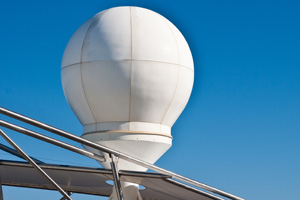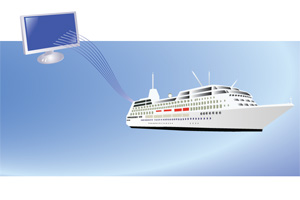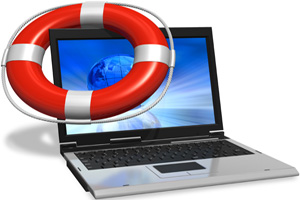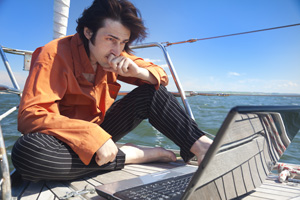| Internet at Sea: 9 Things You Need to Know |
|
|
| published by Cruise Critic http://www.cruisecritic.com/articles.cfm?ID=1419 |
|
|
 Remember a time when cruising truly meant getting away from it all?
Blissfully unaware of work piling up at the office, no cell phones
buzzing with messages or computers cluttering up luggage, the cruiser
simply tuned out and kicked back. Those blissful days are not so long
ago; Norwegian Sky was the first cruise ship to feature an Internet Cafe
when it debuted in 1999. Remember a time when cruising truly meant getting away from it all?
Blissfully unaware of work piling up at the office, no cell phones
buzzing with messages or computers cluttering up luggage, the cruiser
simply tuned out and kicked back. Those blissful days are not so long
ago; Norwegian Sky was the first cruise ship to feature an Internet Cafe
when it debuted in 1999. But times have changed, and the Internet has become such an ubiquitous part of our lives that many of us can barely go 15 minutes, much less a week at sea, without checking e-mail and texts. Yet, while Internet is offered on virtually all seagoing cruiseships (with the exception of a few barebones expedition ships), it is still maddeningly unreliable and slow. Why, in 2012, must using the Internet at sea be so frustrating? To add insult to injury, why must our frustration be so expensive? There are answers, but they are not particularly encouraging. Steve Oosthuizen, the senior IT officer on Crystal Serenity, told Cruise Critic, "Most people don't understand the structure of how communications at sea work, and when they get on a ship [they] expect it to be the same as on land. That is never going to happen." That's the bad news. The good news, however, is that there are steps that lines can take to improve the speed and tricks you can employ to get your Internet fix with less hassle. If you've ever cursed in frustration as your screen froze mid-e-mail or are quivering in fear of being unable to check in as much as you'd like on an upcoming vacation, here are the nine things you need to know about Internet at sea.  1. Internet via satellite will never be as fast as your broadband at
home.
1. Internet via satellite will never be as fast as your broadband at
home. It's the sad truth: Internet at sea is not going to be as fast as on-land connections anytime soon. To understand why shipboard Internet isn't comparable to the broadband you enjoy at home, you first need to understand the technology behind it. The big golf ball-shaped domes visible on top of cruise ships are protective shells that encase freely moving satellite antennae. These antennae transmit a signal from the ship to a satellite, which then sends a signal back down to Earth. Oosthuizen points out that, on land, there might be only two miles of fiber optic cable from your house to a main substation. The jump from your house to substation is virtually instant. But ships have to shoot a signal 22,300 miles into space and then have that signal return to Earth about half a second later. Only then can it jump onto a fiber optic cable where transmission speeds are what you are used to. A bigger limitation to speed is the set amount of bandwidth a cruise line controls. All the data (for example, pages loading from browsing) being sent from the ship to the satellite and back has to use this fixed bandwidth. The clearest analogy is to consider the bandwidth as a straw, and the Internet pages the juice you are trying to drink. The wider the straw (or the more bandwidth the line purchased), the more juice (or Internet pages) can travel through at one time. If more data is being requested than can pass through the straw, the connection will be congested and delivery delayed. In the end, the quality of your Internet signal depends a lot on how much money the cruise line wants to pay. Companies can pay for more bandwidth to make the connection faster, but it's not really cost effective. "Technically you could have any connection you want -- essentially as good as you have at home -- but the costs are just astronomically prohibitive," says Oosthuizen. "It might cost a couple of thousand times more to get something close to shoreside speeds." Finally, river boats (many of which offer free Internet) often offer a particularly frustrating online experience, if only because of heightened expectations. Being so close to civilization, you'd think there should be a quicker connection. However, hills or mountains in the river valleys often block satellite connections, so river ships are forced to use cellular for their primary Internet connection. (Avalon Waterways estimates that, on its European itineraries, the ships will use cellular signals for Internet 92 percent of the time.) When the ship is near a cell phone tower, newer 3G or 4G service can provide faster service than what can be delivered through satellite. The disadvantage comes in areas with a lack of cell towers, where the cell signal is weaker and the connection speed slower.  2. Satellites don't come cheap -- so neither will Internet access at
sea.
2. Satellites don't come cheap -- so neither will Internet access at
sea. The satellites used for at-sea Internet connections cost hundreds of millions of dollars. Oosthuizen explains that "One consumer -- a cruise line -- can't afford to keep a satellite up in space. If we could, we'd have a brilliant connection. But instead the signal gets chopped up into a multitude of users, invariably slowing it down." He contrasts the huge potential customer base that satellite providers have in the United States and other heavily populated areas with the much smaller number of customers at sea. Many users can share the costs on land, while only a relatively few cruise ships, cargo ships and oil rigs can share the cost at sea. Inevitably, fewer users means higher costs. Currently one company, MTN Satellite, has a virtual monopoly on the cruise industry, with service on more than 80 percent of cruise ships sailing. While MTN doesn't actually own the satellites, the company rents space on the required frequency from satellite owners and, because of the accumulated volume it represents, can offer a much lower cost than any potential competitor. (MTN also supplies most ships with television and newspaper service, among other electronic services.) Jonathan Selby, who runs his own consulting business working with passenger ships on communication issues, notes that MTN is probably taking a percentage of profits. "On the Internet and with cell phones, MTN normally shares revenue with the ship. So in order for everyone to make money, the costs have to go up to the consumer." How much will you spend? Typical onboard Internet prices are 75 cents a minute, though you can buy packages offering 60, 90 or 150 minutes that work out to be cheaper on a price-per-minute basis. 3. When onboard Internet is unreliable, the ship is not always to blame. If you've cruised enough, you know that at some point, shipboard Internet simply won't work. Addicted as we are, we get frustrated and blame someone -- anyone -- assuming it is the ship or cruise line's fault. But, is it? While cynics might speculate that cruise lines want slower connection speeds to drive up revenues onboard, the reality is that unreliable Internet can hurt the bottom line. According to a recent study by TripAdvisor, 57 percent of British vacationers check their e-mail when on holiday in order to reduce the workload when they get back to the office. Many potential cruisers feel like Dave, who posted on Cruise Critic's blog, "One of the reasons I've never been on a cruise is the absence or high cost of Internet access." In actuality, slow Internet connections are beyond a cruise line's control. In order for there to be a connection, the antenna needs to be pointing at, and have an unobstructed line of sight to, the satellite. But sometimes that pathway between the antenna and the satellite is blocked. In port, it might be that a tall building is directly in between the ship and satellite. In the Norwegian fjords, the tall mountains often block satellites, so don't count on satellite reception there. However, it is true that the ship itself can block a signal -- on certain courses, the funnel or mast might be between the antenna and satellite. Oosthuizen points out that we shouldn't forget that, despite our frustrations, this is amazing technology. "To keep a dish pointing at a satellite in space while the ship moves and rolls and changes course is, by itself, amazing." The ship's antenna must be stabilized, meaning it reacts to the ship's position and course and movements, and must be pointing at the satellite with an accuracy of one degree. When the ship has to change course particularly quickly, it isn't uncommon for the signal to be lost temporarily. (Consider this yet another reason to back up what you're writing frequently.) Yet, barring any obstructions, you can still get an Internet signal down in Antarctica and as far north as 80 degrees north latitude in Svalbard.  4. head for the Equator for a better connection.
4. head for the Equator for a better connection. Here's a reason to take that exotic cruise: the closer you are to the equator, the more reliable your Internet service is likely to be. In order for satellites to have the maximum possible coverage, or footprint, they are positioned in a geostationary orbit above the equator. A ship on the equator will, therefore, have the satellite directly overhead; the farther from the equator the ship is, the closer the satellite will be to the horizon. This means the antenna is pointed at a lower angle, increasing the chance that a mountain or part of the ship will block the signal. If the Norwegian fjords were closer to the equator, there would be basically no connection issues, despite the challenge of the high mountains. Also, the signal is strongest in the center of a satellite footprint and weakest as the edges are approached. Thus the connection speed will increase or decrease as the ship moves into or out of the footprint. While most cruisers are unaware of footprints and satellite coverage, you can get an idea of where those footprints are by viewing maps on the MTN Web site. 5. There are work-arounds for travelers who must get online on vacation. For those searching for the fastest Internet connection, the best tip is to use the Internet when few people are online, such as late at night or in port when most passengers are ashore. The more people online sharing the limited bandwidth, the slower the connection will be. Using the straw analogy, imagine you are trying to move more juice through the same-sized straw. Unfortunately, there isn't much else an individual cruiser can do. Users won't find any difference between connecting through Wi-Fi or through a cable to a potential data port in their cabin, nor will the ship's Internet Cafe offer any difference in connection. Of course, the fastest connection will always be onshore, and for those who simply want to check that all is well at home, using free Wi-Fi in port with your smartphone may be the best route. During my last two cruises in the Mediterranean and two cruises in the Caribbean this year, I've managed to find free Wi-Fi ashore near the pier in almost every port. Local tourism offices (or even the ship's crew, who seem to know all the hotspots in the ports they frequent) can be very helpful in pointing out where you can quickly connect and check your messages at your convenience. Another useful tip is to simply write your e-mail in a Word program or an offline version of your e-mail provider, and then paste what you've written into an e-mail (or hit send) as soon as you log in. It's best to have your own laptop if you want to take this approach, as many onboard computer terminals have been re-jiggered so you cannot access basic word processing programs like Microsoft Word or Notepad. This won't change your connection speed, but it may save you money and give you a better chance of actually getting your e-mail sent.  6. Cruise ships do have a few tricks they can use to improve
connection times.
6. Cruise ships do have a few tricks they can use to improve
connection times. Crystal invested a significant amount of money in 2011 to improve its connection speed, and it's a good example of steps that other lines could take ... if they're willing to spend the money. Using a Web accelerating company, the line installed two devices. The first is a proxy that identifies Web pages that have already been accessed. For frequently accessed Web pages, such as Facebook or the New York Times, the system stores the information needed to load the pages. This means that redundant data is not transmitted again and again every time someone visits one of those Web sites. With less data being transmitted via satellite, the page can load more quickly. Crystal also uses a package shaper, which assigns higher priority to certain groups of traffic. Oosthuizen says that passenger Internet is the highest priority -- 80 percent of the total bandwidth capability goes to passengers. However, the mail server for company e-mails is allocated only 5 percent, so potentially large messages, such as passenger manifests that the ship needs to send ashore, won't be able to hog bandwidth capacity for passengers. They can also give certain users priority. For instance, the cruise sales office gets a higher priority so that when a cruiser sits down to consider another cruise, a fast, live connection will quickly check availability. Oosthuizen believes that, by using these innovations, Crystal has reduced the data going through the same connection by 50 to 70 percent, allowing for significantly faster speeds. 7. Don't expect to Skype onboard anytime soon. Skype -- an Internet-based phone and video chat service -- would be ideal for staying in touch with family, friends, colleagues and clients while on a cruise. But many ships either block the Web site altogether or have a connection that is so slow as to make it unworkable. When used with video capability, Skype is particularly troublesome as it automatically detects bandwidth limitations and tries to use as much of the fast connection as possible. Oosthuizen explains that, "Skype has been developed in a way that it always tries to improve voice quality as much as it can ... and this hogs bandwidth. For this reason, we block Skype onboard; two people on Skype can effectively kill the connection speed [for everyone else]." While not all lines ban Skype, more and more do, along with Web sites with streaming media like YouTube, which also use a proportionally high amount of bandwidth.  8. Turn your cell phone off to save money.
8. Turn your cell phone off to save money. Cell phones are a particularly easy way to rack up expensive charges very quickly, as the caller is essentially billed by two companies. MTN sets up a mini-cell tower on the ship and charges for the transmission that takes your voice and sends it to the satellite and back down to land. In addition, your cell phone provider (AT&T, Verizon, etc.) also charges a roaming rate. While you don't see a separate line in your bill from MTN, rest assured it is getting a cut. If you're looking to minimize costs, beware of incoming text messages. Keep your cell phone off -- or in airplane mode -- to prevent these charges, and don't use the mobile network provided by the ship to download messages. Data costs while roaming on a mobile network can be very heavy, so if you didn't bring your laptop and want to use your phone to surf or check messages, you are better off using the ship's Wi-Fi service. (Just turn off your phone's ability to access mobile signals, but keep the Wi-Fi ability active.) The rate is the same whether using a laptop or a cell phone, and those that want to quickly check messages need only log on for the few minutes it takes to download messages before signing off. Those who want to surf are still better off since they are not being charged for both data and minutes while roaming. The best bet for smartphone users, however, is to find that free Wi-Fi hotspot ashore -- and download all your e-mails at no charge. 9. There's hope for the future. There are other technologies that may prove helpful to the cruise industry in the future. For instance, several small expedition ships are now using Iridium OpenPort technology as a backup for their own internal use and for emergencies. This satellite system has worldwide coverage, and it allows data to be sent virtually anywhere. However, the capabilities are geared towards smaller vessels at the moment, and the cost is prohibitively expensive for the majority of today's cruisers. For riverboats, the emergence of 4G networks will ensure faster connections than the current 3G cellular networks that are currently common. Another development is INMARSAT's recent courting of expedition cruiseships. INMARSAT uses a different frequency band to provide worldwide communication, and it's so reliable it has been a safety requirement of the International Maritime Organization for all ships to have an INMARSAT terminal onboard. While the company has just begun branching out to provide improved (and cheaper) connections on small expedition ships off the main commercial tracks, the most exciting development in many years may be INMARSAT's ambitious plans for a new $1.2 billion network. While this new service is at least a few years away, technological advances (including operating on a different spectrum) will allow INMARSAT to offer faster connections with more capacity at cheaper prices -- and possibly threaten MTN's dominant position. Stay tuned .... --by Ben Lyons, Cruise Critic Contributor |